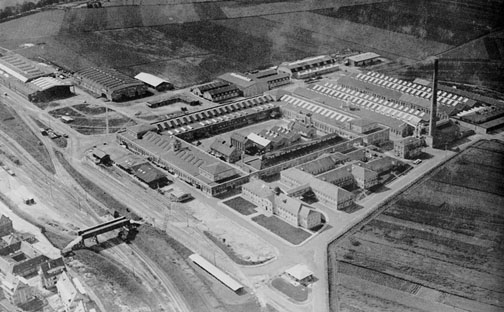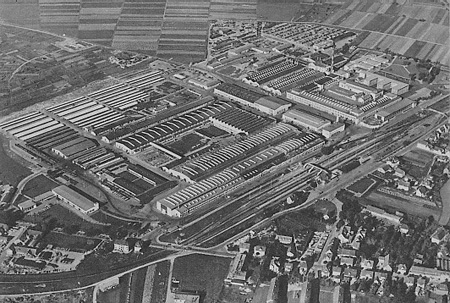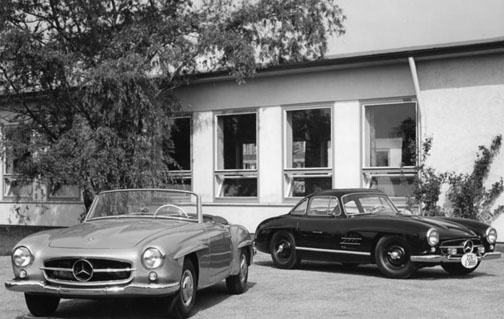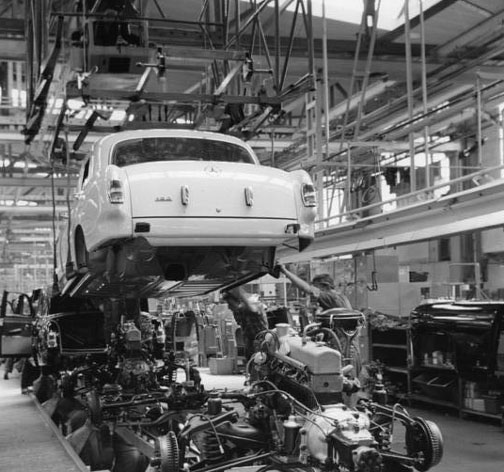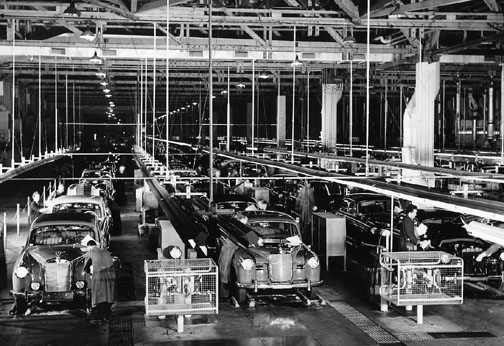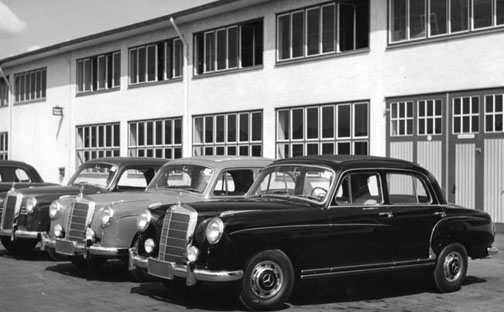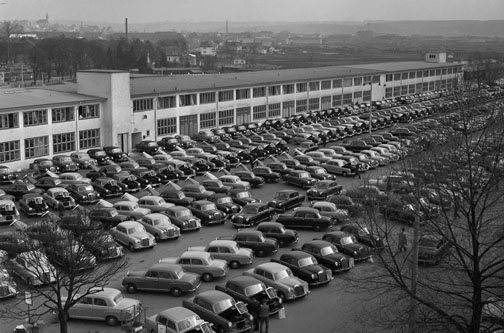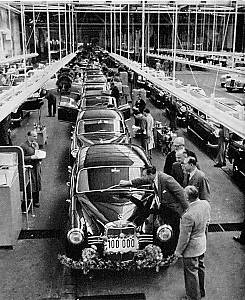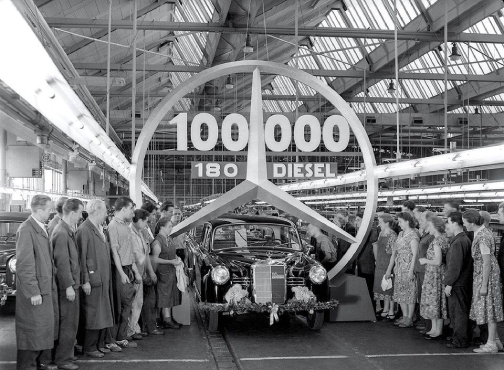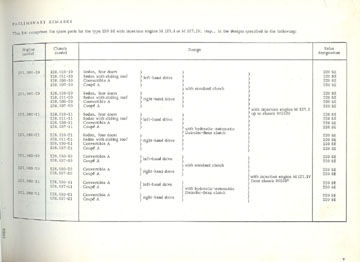Overview of Mercedes-Benz Ponton
Models and Production Data
- Historical Perspective
- Ponton Models
- Sindelfingen Sends Its Best
- Production Data
- Annual Production Data by Model
| Terms / Conditions / Disclaimer | © www.mbzponton.org |
Historical Perspective
Photo 1. 1939 aerial photo of the Daimler-Benz Sindelfingen Works
As one of the leading industrial complexes in Germany, Daimler-Benz was a prime target for Allied bombers in World War II. In the First World War, the Mannheim-based Benz & Co. and the Stuttgart-based Daimler Motor Company (the two predecessor firms of Daimler-Benz AG) had suffered a lot of disruption but no actual physical damage; it was not so fortunate the second time around. In September of 1944, two weeks of daylight air raids left 60 years of Daimler and Benz history in smoldering ruins.
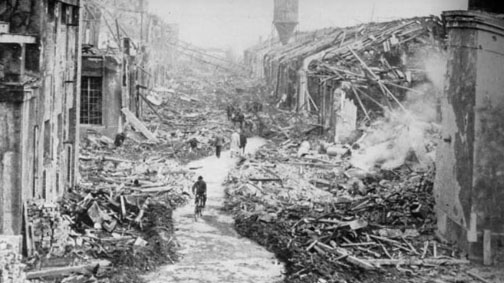
|
Photo 2. Daimler-Benz buildings in ruins after the Second World War
The main plant at Stuttgart-Unterturkheim was listed as 70% destroyed; the vast aero engine and coach-building works 13 miles away at Sindelfingen suffered 85% destruction; 80% of the truck works at Gaggenau was leveled; the original Benz und Cie site at Mannheim escaped with the least damage at 20%; the Berlin-Marienfeld works which Daimler bought in 1902 and later devoted to diesel and aero engines was totally bombed out.
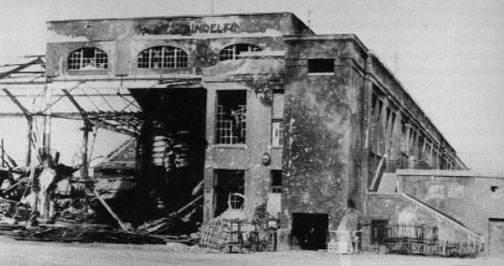
|
Photo 3. Daimler-Benz Sindelfingen building, circa 1945
Hardly more than a skeleton of Daimler-Benz Aktiengesellschaft survived the war. The Board of Directors issued a statement in which they declared that "Daimler-Benz had ceased to exist in 1945."
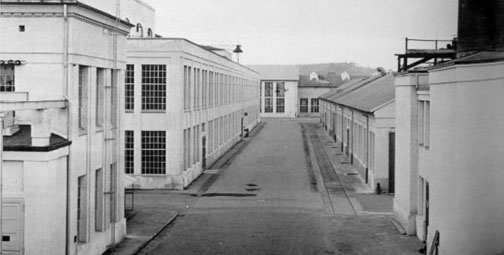
|
Photo 4. New Daimler-Benz buildings after reconstruction — early 1950s
As early as 1946, the pieces were beginning to be put back together. Production resumed with pre-War models such as the Type 170V. Slowly, production increased and other models were offered such as the Type 170S and 170D. The 170D (diesel) was primarily intended to be used as a taxi. In 1949, there were 17,000 units produced. These small, low powered automobiles were suitable for the austere post-War environment.
|
|
Photo 5. DBAG Sindelfingen Works, circa 1955
The Sindelfingen Works – where the world famous Mercedes-Benz passenger cars were produced during the 1953-1962 Ponton era, and modern production continues to the present day.
Ponton Models Introduced in 1953
The Mercedes-Benz Ponton body style began production in 7/1953 and was introduced to the public in the autumn of that year. It eventually replaced the Type 170 series which was a post-War production of a pre-War car. Following the Type 300 "Adenauer" limousine, this was another totally new car from Daimler-Benz at this point in history. As Germany slowly recovered from the disasters of the Second World War, more and more people could afford a car. Of course, more people were also able to afford a Mercedes-Benz.

4 cylinder sedan
(W120 / W121)

4 cylinder roadster
(W121)

6 cylinder sedan
(W105 / W128 / W180)

6 cylinder cabriolet
(W128 / W180)
These new cars were available in different body and engine types. First, the basic four cylinder side-valve engine version, the 180 sedan (7/1953-6/1957) replaced by the 180a sedan with an overhead valve engine with an overhead camshaft (6/1957-7/1959) joined by the 190 sedan (3/1956-8/1959).
The 190 sedan was a combination of the 180 body and a modified engine from the 190SL roadster (5/1955-2/1963) having one Solex carburetor instead of the two twin barrel carburetors which are fitted to the SL model. In outward appearance, the 190 models are distinguishable from the 180 models by having a chromium plated strip under the side windows. Both the 180 and 190 sedans were available with optional diesel engines which made them very popular as taxis.
In 1959, the 180b and 190b sedans were introduced, incorporating several modifications, including a redesigned sub-frame for the front suspension unit. The production of the "b" version of the four cylinder (gasoline and diesel) sedans lasted until 10/1962.
A sliding fabric sunroof (made by Webasto) was available as a factory option on all four and six cylinder sedan models. A far less common option was the steel sunroof (made by either Webasto or Golde) available on both four and six cylinder sedans and coupés.[1]
The more valuable Pontons were the six cylinder cars. Included are the 220a (6/1954-4/1956) replaced by the 219 (3/1956-7/1959) joined by the 220S (3/1956-8/1959), and 220SE (10/1958-8/1959). Even more luxury was available in Ponton shape. Both the 220S and 220SE were available as a coupé or cabriolet.
There were also three sports cars produced by Daimler-Benz at this time. The six cylinder, two-seater 300SL "Gullwing" coupé (8/1954-5/1957), the four cylinder, two-seater 190SL coupé-roadster (5/1955-2/1963), and the six cylinder, two-seater 300SL roadster (8/1957-2/1963).
The chassis of the 190SL roadster was of unitary construction like that of the sedans, coupés and cabriolets while the 300SL (both the "Gullwing" and later, the roadster) had a unique light-weight tubular "space frame" on which the body panels were supported. The outward appearance of all the SL (Sports Leicht) roadsters was similar and they remain very popular today.
Sindelfingen Sends its Best
Sindelfingen is a city of some 60,795 residents (2014) located 13 miles southwest of Stuttgart, the main headquarters today of Daimler AG. It was the home of scarcely 23,000 inhabitants when the Mercedes-Benz Ponton sedans, coupés, cabriolets and roadsters were being produced and assembled there by Daimler-Benz, A.G. from 1953-1962. The Sindelfingen factory itself employed some 19,000 people during those years.
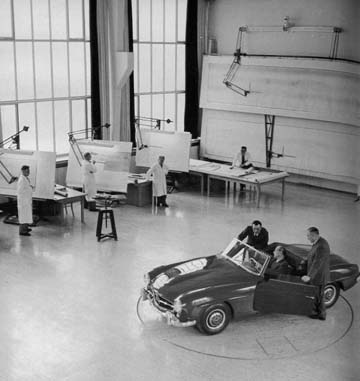
Photo 7. Mercedes-Benz Type (W121 II) 190SL roadster-cabriolet
The interior of the post-War buildings at Sindelfingen enabled the entire staff to make a fresh start in more ways than one. This photo, dating from March 1955, shows one of the first Type 190SL roadster-cabriolets being scrutinized by the design management team.
The body styling for the Mercedes-Benz Pontons was accomplished by Karl Wilfert and his team with his "head-designer", Friedrich Geiger.
Here are two scans. On the first, you can see Karl Wilfert (left), and Friedrich Geiger (far right). The other is part of a Daimer-Benz organization chart on which you find both names, and can see where Friedrich Geiger was positioned. "Entwicklung PKW Aufbauten" means Development of Sedan Bodies. "Stilistik" means Styling. Friedrich Geiger also was responsible for the design of all 300SL series. [10]
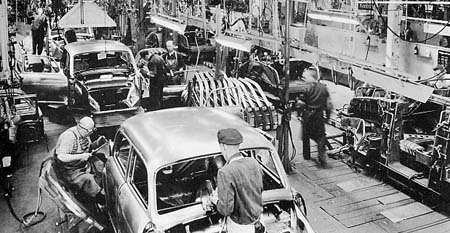
|
Photo 9. Ponton sedans being assembled at Sindelfingen
Photo 10. Bringing body together with engine, sub-frame, transmission / Sindelfingen / May 1956
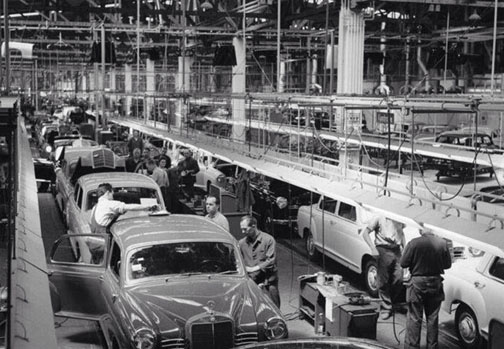 |
Photo 11. Ponton production line at Sindelfingen / May 1956
The major work of the Daimler-Benz Sindelfingen factory was the development and production of four and six cylinder sedans in large series.
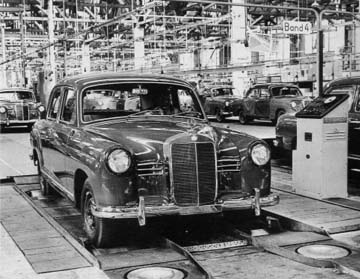
|
Photo 12. Type 180 Ponton sedan at a diagnostic testing station
Several hundred of these cars left the factory daily and demonstrated throughout the world – exported to 136 countries – the Sindelfinger's quality workmanship. Light-duty truck cabs were also built at the facility, while engines were built and tested in Untertuerkheim.
Photo 13. Mercedes-Benz Ponton sedans in production at Sindelfingen
At Daimler-Benz, developments in engineering, manufacturing and economics dictated when new parts and sub-assemblies were fitted to models in any given range, including the 1953-1962 Ponton passenger vehicles. Unlike the American method of introducing all changes at the beginning of a model year, Mercedes-Benz vehicles retained the same body shape for a longer period, while continuous minor technical improvements were made throughout the lifespan of the model.
Photo 14. Type 220S Ponton sedans with Webasto sunroofs / Sindelfingen / May 1956
Fortunately, accurate records were kept indicating which parts were installed on each car and engine. Still, it may be a challenge for the owner and agents (both authorized, and after-market) to obtain the correct part for any given vehicle.
Typically, there were cut-off points, meaning the illustrated parts catalogs indicate a certain part number was used up to a particular chassis number, at which point, the next part number started being used. It is for this reason that the Mercedes-Benz Ponton owner needs to reference their chassis and engine numbers when ordering replacement parts for their Ponton. For details, see the Chassis and Engine Number page.
|
|
Photo 16. Festive acknowledgement of the 100,000th Type 180 Ponton sedan
Photo 17. The 100,000th Type 180D Ponton sedan
In a 1960 DBAG publication about the Sindelfingen factory it was reported that it took approximately 1,500 minutes to build a passenger vehicle.[2] This was from the time the first sheet steel molding was pressed, to the moment when the car rolled from the finishing hall into the sales department.
Along with the Type 300 "Adenauer" limousine, the 190SL and 300SL touring sports cars were also manufactured in series production although in considerably fewer numbers. They were also "finished" on the assembly line but as distinguished from the large series, a great deal more hand work went in to them.[3]
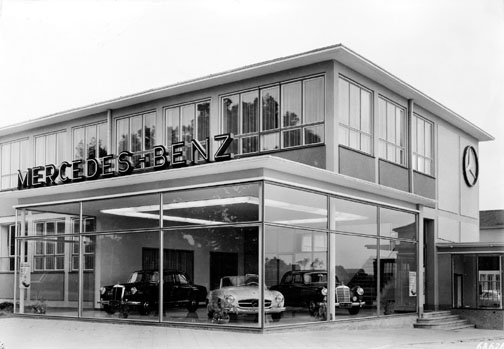
|
Photo 18. Mercedes-Benz factory showroom during the Ponton era
Mercedes-Benz Ponton Production Data [4]View Mercedes-Benz Ponton Variant Production Data (separate page) | ||||||
|
Model |
Engine |
Engine Prefix |
Body Style |
Chassis Code |
Dates |
Production |
| 180 | 4-cylinder gasoline | M 136.925 | sedan | W120 I W120.010 W120.011 * |
7/53-6/57 | 52,186 |
| 180a | 4-cylinder gasoline | M 121.923 | sedan | W120 II W120.010 W120.011 * |
6/57-7/59 | 27,353 |
| 180b | 4-cylinder gasoline | M 121.923 | sedan | W120 III W120.010 W120.011 * |
7/59-8/61 | 29,415 |
| 180c | 4-cylinder gasoline | M 121.927 | sedan | W120 IV W120.010 W120.011 * |
6/61-10/62 | 9,280 |
| 180D | 4-cylinder diesel | OM 636.930 | sedan | W120 I W120.110 W120.111 * |
2/54-7/59 | 116,485 |
| 180Db | 4-cylinder diesel | OM 636.930 | sedan | W120 II W120.110 W120.111 * |
7/59-8/61 | 24,676 |
| 180Dc | 4-cylinder diesel | OM 621.914 | sedan | W120 III W120.110 W120.111 * |
6/61-10/62 | 11,822 |
| 190 | 4-cylinder gasoline | M 121.920 | sedan | W121 I W121.010 W121.011 * |
3/56-8/59 | 61,345 |
| 190b | 4-cylinder gasoline | M 121.920 | sedan | W121 III W121.010 W121.011 * |
6/59-8/61 | 28,463 |
| 190D | 4-cylinder diesel | OM 621.910 | sedan | W121 I W121.110 W121.111 * |
8/58-7/59 | 20,629 |
| 190Db | 4-cylinder diesel | OM 621.910 | sedan | W121 III W121.110 W121.111 * |
6/59-9/61 | 61,309 |
| 190SL | 4-cylinder gasoline | M 121.921 M 121.928 [6] |
coupé | W121 II W121.040 |
4/55-12/62 [8] | 25,881 |
| roadster | W121 II W121.042 |
|||||
| 219 | 6-cylinder gasoline | M 180.921 [7] | sedan | W105 W105.010 W105.011 * |
3/56-7/59 | 27,845 |
| 220a | 6-cylinder gasoline | M 180.921 | sedan | W180 I W180.010 W180.011 * |
6/54-4/56 | 25,937 |
| 220S | 6-cylinder gasoline | M 180.924 | sedan | W180 II W180.010 W180.011 * |
3/56-8/59 | 55,279 |
| coupé |
W180 II W180.037 |
4/56-10/59 [5] | 1,251 | |||
| cabriolet | W180 II W180.030 |
4/56-10/59 [5] | 2,178 | |||
| 220SE | 6-cylinder
gasoline (fuel-injected) |
M 127.980 [11] | sedan |
W128 W128.010 W128.011 * |
10/58-8/59 | 1,974 [9] |
| M 127.983 [12] | coupé | W128 W128.037 |
7/58-11/60 [5] | 830 [9] | ||
| M 127.983 [12] | cabriolet | W128 W128.030 |
7/58-11/60 [5] | 1,112 [9] | ||
Notes
|
||||||
Table 1. Mercedes-Benz Ponton Production Data
Annual Mercedes-Benz Ponton Production Data by Model [13] |
|||||||||||||
| Produktion | 1953 | 1954 | 1955 | 1956 | 1957 | 1958 | 1959 | 1960 | 1961 | 1962 | 1963 | Total | |
| 180 | 4362 | 20,306 | 17,704 | 8,464 | 1,350 | 52,186 1) | |||||||
| 180a | 4,656 | 15,967 | 6,730 | 27353 2) | |||||||||
| 180b | 7,314 | 14,384 | 7,717 | 29,415 3) | |||||||||
| 180c | 4,980 | 4,300 | 9,280 4) | ||||||||||
| 180D | 11 | 15,532 | 20,345 | 21,013 | 22,910 | 26,693 | 9,981 | 116,485 5) | |||||
| 180Db | 8,076 | 11,151 | 5,449 | 24,676 6) | |||||||||
| 180Dc | 4,822 | 7,000 | 11,822 7) | ||||||||||
| 190 | 16,001 | 22,578 | 15,791 | 6,975 | 61,345 8) | ||||||||
| 190b | 6,613 | 12,986 | 8,864 | 28,463 9) | |||||||||
| 190D | 5,469 | 15,160 | 20,629 10) | ||||||||||
| 190Db | 13,709 | 29,116 | 18,484 | 61,309 11) | |||||||||
| 190SL | 1,727 | 4,032 | 3,332 | 2,722 | 3,949 | 3,977 | 3,792 | 2,246 | 104 | 25,881 | |||
| 220a | 4,178 | 19,348 | 2,411 | 25,937 | |||||||||
| 219 | 5,474 | 8,505 | 9,296 | 4,570 | 22,845 12) | ||||||||
| 220S | 10,525 | 15,459 | 20,181 | 9,114 | 55,279 13) | ||||||||
| 220S coupé u. cabriolet |
297 | 1,066 | 1,280 | 786 | 3,429 14) | ||||||||
| 220SE | 201 | 1,773 | 1,974 | ||||||||||
| 220SE coupé u. cabriolet |
114 | 628 | 1,200 | 1,942 15) | |||||||||
| 1) einschl. 279
Fahrgestelle 2) einschl. 198 Fahrgestelle 3) einschl. 382 Fahrgestelle 4) einschl. 183 Fahrgestelle 5) einschl. 2,439 Fahrgestelle 6) einschl. 400 Fahrgestelle 7) einschl. 222 Fahrgestelle 8) einschl. 354 Fahrgestelle 9) einschl. 349 Fahrgestelle |
10) einschl. 136
Fahrgestelle 11) einschl. 711 Fahrgestelle 12) einschl. 3 Fahrgestelle 13) einschl. 11 Fahrgestelle 14) Cabriolet 2,178, Coupé 1,251 Wagen 15) Cabriolet 1,112, Coupé 830 Wagen |
||||||||||||
|
Translations
|
|||||||||||||
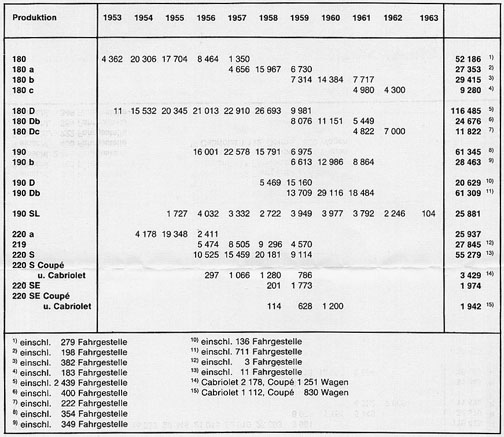 |
|||||||||||||
| Source: Mercedes-Benz Personenwagen 1886-1986 / Werner Oswald / ISBN-13: 9783613011335 / ISBN-10: 3613011336 | |||||||||||||
Table 2. Annual Mercedes-Benz Ponton Production Data
Independent Survey of Surviving
|
|||||
| Revision D / September 15, 2020 | |||||
|
Contact Detlef Gonzalez / Bergisch Gladbach, Germany Website mbig.de/clubleben/ponton-coupecabrio-register.html Survey Ponton Coupé/Cabrio Register Questionnaire |
|||||
Hello Worldwide Ponton Owners! |
|||||
| W180 220S Coupé and Cabriolet | |||||
| 1956 | 1957 | 1958 | 1959 | ||
| 220S Cabriolet | |||||
| Manual transmission | 56 | 107 | 77 | 52 | |
| Hydrak | 0 | 16 | 41 | 27 | |
| RHD all transmissions | 0 | 10 | 7 | 3 | |
| 220S Coupé | |||||
| Manual | 0 | 33 | 62 | 26 | |
| Hydrak | 0 | 6 | 27 | 16 | |
| RHD all transmissions | 0 | 2 | 2 | 2 | |
| Subtotal | 56 | 174 | 216 | 126 | 572 |
| W128 220SE Coupé and Cabriolet | ||||
| 1958 | 1959 | 1960 | ||
| 220SE Cabriolet | ||||
| Manual transmission | 19 | 32 | 161 | |
| Hydrak | 0 | 2 | 28 | |
| RHD all transmissions | 0 | 0 | 12 | |
| 220SE Coupé | ||||
| Manual transmission | 11 | 25 | 102 | |
| Hydrak | 0 | 0 | 15 | |
| RHD all transmissions | 0 | 3 | 6 | |
| Subtotal | 30 | 62 | 324 | 416 |
This data makes a grand total of 988 cars. I have about 60 more not included in the data so far, for some reason or other. In production, the 220S cabriolets were the most numerous (2,178 units) but are under-represented in the survey data – possibly indicating higher numbers parted-out in benefit of cabriolets in the past. The SE models are over-represented in the data, which could lead to the conclusion that owners cared more for those more limited number of cars. I’d like to clear up the mystery about the Webasto steel sliding sunroof on the coupés. Every now and then we hear rumors about the “rare steel sliding sunroofs.” Of all 338 registered coupés, 116 are fitted with the steel sliding roof and 103 out of the 338 owners did not give any information about the car’s options, or were not given in the advertisements where the data came from. If you add some out of the 103 to the 116 known ones, it seems that about 40 + percent of all cars had the option – mostly from the production line. Some were refitted with an aftermarket brand, “Golde” steel sliding roof – we have one in our register. Another car is known to have been fitted with a foldable roof like on the sedans. It is not yet confirmed to be out of the production lines. I also have copies of letters from Mercedes-Benz written to their dealerships, where they offer to fit the original Webasto sliding roof after delivery at tremendous cost. Finally, it is suspected that most of the roofs with the sliding roof option survived after a coupé was scrapped or parted-out and then grafted onto cars without the option, which finally falsifies the data a bit. There are some cars known with a floor mounted gear shift. To date, there has been no evidence to prove it was a factory option, even though it is well known that Mercedes-Benz made many things possible to long-term customers or ones buying larger number of cars. If one of you has one of those cars with the option built in upon delivery, and has the evidence of that, you are very welcome enlighten me. Mercedes-Benz offered three different color schemes on the Pontons. A one-tone, a two-tone, and a three-tone! We have official documents where Mercedes-Benz asks their dealerships to talk customers out of the three color schemes as much as possible, but agreed to deliver any customer-demanded combination. In our register, we found that the highest number of single colored cars were painted Black 040, followed by White Grey 158, Ivory 608, and Light Blue 356. As many as we found in Black, we have found in the two-tone coloring. Three color schemes were rare. Finally, it’s no wonder the cars that were re-sprayed in a different color, were the White Grey 158, Black 040, Anthracite Grey, Light Blue 356 and Creme 439 ones. On the other hand, for re-spraying a lot of people chose Black 040 as a new color, Dark Blue 332, some White 050 but none chose White Grey 158 as a single color scheme. Considering the leather interior, we find four main colors were ordered often. Creme 1060, Red 1079, Light Red 1088, and Beige 1068. Congratulations if you own a car with combinations like Yellow Creme 629 with Light Red 1088, Turquoise 250 with Creme 1060, or Grey Beige 716 with Dark Green 1073. You might have the only one with that combination. The standard wood was Palisander, Burlnut, and the rarer Macassar. If you own one in Bird’s-Eye Maple or Light Birch you own one of the very few indeed. Carpet colors usually matched the chosen leather color. Rubber floor mats were added for the front in colors Creme, Olive Green, Light Brown or Grey, and they came in the same color as the door entry (threshold) rubber lining. At the beginning of production, the rubber mats were surrounded by a small leather bordering, which was changed later to an embossment. Ponton coupé/cabriolet trunks all look different. Some have the same velour carpets as up front. Some are fitted with a combination of leather and velour carpets, and others even have a leather interior. Sometimes all these combinations look really great. If that is what you care about, it’s fine – but they were never delivered that way. All trunks were simply covered with velour carpet on the sidewalls and intermediate wall behind the back seat, and rubber mats on the trunk floor. There was only one color for this carpet. That's it. Focusing on the production numbers again, I conclude, due to different facts that we have to expect about 2,000 total survivors. The production ratio between coupé and cabriolets was 3 to 2. Many coupés were parted out in the past for the benefit of the higher valued cabriolets. That means we may have to expect about 700 coupés and 1,200 cabriolets. The production ratio between S and SE types was about 2 to 1. That concludes it is most likely that the SE coupés are the rarest species to come across, followed by the SE cabriolets. The first cabriolet we found so far was registered in September 1956. Even if some literature tells us that there were coupés delivered in 1956, it seems doubtful. According to confirmed sources, the presentation of the coupés took place on the Salon D`Automobil in Paris in September 1956 We know the first one was delivered on January 30, 1957 as the car on display at the Geneva Autosalon in Switzerland in March 1957. It has the body-number 7500002. In 2015, a German dealership claimed to be in possession of a xxx001 model, and was going to offer it for $440-550k. The last car. The founder of our Ponton research found a spare aluminum sheet metal part of the roof that sits under the sun visors in all coupés in his basement. Engraved by hand, someone wrote, “The final curtain 09.19.1960.” That part belonged for sure to the 220SE coupé with the body number 128037-10-00437. If the saddler finished his work on the 19th, it is to be suspected the car was delivered maybe a week or two later. In early 2015, I contacted the Mercedes-Benz Classic Center in Stuttgart about the VINs and dates of delivery and production of the last coupés and cabriolets. We'll see. After quite a while I got an answer. The cars with the highest and therefore last given VIN numbers of each derivate were not necessarily the last delivered ones. For example, the 220SE coupé with the highest VIN left the factory on 11/8/1960, but seven more were delivered during November 1960. Same with the 220SE cabriolet. The car with the highest VIN left the production line on 11/7/1960 but 29 more were delivered in November 1960 when production had officially ended. Nevertheless two more cars left the factory after that. One in December and the final one on 01/02/1961 with shipping to the USA. Once more, I encourage you to view my questionnaire and sent me some data on your cars. If you feel uncomfortable doing so, just send me an email with your car’s VIN, and let me know if it's scrapped, drivable, undergoing restoration or already fully restored. That will help get an overview about the total number of survivors. Detlef Gonzalez |
||||
Table 3. Mercedes-Benz Ponton Coupé and Cabriolet Survey Data
Footnotes / References (I)
[1] Examples of four and six cylinder Ponton models fitted with a Golde and Webasto steel sunroofs
• Golde steel sunroofs and Ponton chassis numbers
• 1956 Type 190 sedan with a steel sunroof / Haifa, Israel
• Type 220S sedan with steel sunroof / Beirut, Lebanon
• 1957 Type 190 Ponton sedan with Golde steel sunroof / Rancho Cucamonga, California
• 1959 220S sedan with Golde steel sunroof (chassis number 180.010-10-9502328) / Norway
• 1959 220S sedan with Golde steel sunroof / Sacramento, California
Steel sunroof by Webasto
• 1958 220S sedan with Webasto steel sunroof (detail of handle and track) / Raymond Vargas / Fresno, California[2] DBAG factory publication: "Scheinwerfer" / © 1960. The time to build the four and six cylinder sedans is stated correctly at 1,500 minutes. That is equivalent to 25 hours, or roughly three (eight-hour) work days. There are a couple of things to note here. The context of the "1,500 minute" figure was that of someone on a guided tour of the Sindelfingen factory forcing the tour guide (an engineer) to answer the question "How long does it take to build a car?" Of course, there is the design phase, external suppliers of raw materials, development, testing, and more that need to be considered. These really make the 1,500 minute figure misleading. So, I think the tour guide was saying, "Once all the raw materials are in place at the factory, and all of the workers are present and perform flawlessly, and all the machines are working properly, and it is a sunny, 22º C (72º F) summer day, and the design and development phase is factored out, then you may use the figure as a rough idea of how long it takes to build a four or six cylinder sedan."
Remember that there are exceptions to these numbers, and they merely serve as a general reference. For example: Let us say a certain 220S Ponton cabriolet takes five months from the time the original data plates or paperwork declare it was created until the time it was ready to be delivered. There are circumstances that could logically explain why this might happen. Perhaps, the customer changed their mind on some of the optional equipment such as interior leather color, radio, roof color, body color. The factory would not look with favor on that decision, particularly if the customer waited until near the time of delivery to make it. This would put a potentially long delay on getting the car delivered in the original agreed period of time because the new request would need to be worked into the factory schedule and actually implemented on the car.
[3] According to Hartwig Mueller (Mercedes-Benz salesman from 1956 to 1964 trained in Stuttgart-Untertuerkheim, Main-Administration-Center) the Sindelfingen factory also produced the 220S and 220SE coupés and cabriolets, as well as the Type 300 "Adenauer" limousines. However; these models were not mentioned directly in the documentation used to create this web page.
[4] Mercedes-Benz Automobile 4 / Vom 170V zum 300SL / © 1981 Heribert Hofner / ISBN: 3-405-12604-5 / Referenced for all models (except the 220S/220SE coupé & cabriolet) production dates and numbers.
[5] Mercedes-Benz 1886-1986 vol. II / © 1986 Edita S.A. / Printed in Italy / ISBN: 2-88001-194-9 / Referenced pp. 254 & 256 for Type 220S/220SE coupé & cabriolet production dates and numbers / Courtesy: Gerhard Pieterson (South Africa).
[6] The 121.928 engine (Type M 121 B IX) was used on the 190SL from chassis 022122 until the end (8/1961-1962).
[7] Service Manual Models 180 to 220SE (SM-1201-000). In the table on page 00-1/7, we find that the 220a has a chassis type 180.01, engine model M 180.II (180.921). The same table recites that the Type 219 sedan has a chassis type of 105.01 and engine model M 180.II (180.921). That is, this manual states that the 219 and 220a have a different chassis but the same engine. See also pictures and text at pages 01-4/4 to 01-4/5, which show both sides of a 180.921 (single carburetor) and 180.924 engine and recite that the 180.921 went into the 220a and 219 and that the 180.924 went into the 220S.
[8] Mercedes-Benz 190SL, 1955-1963 - Restoration and Ownership / © 2003 Bruce Adams and The International 190SL Group USA / ISBN: 0-9729420-0-9. On February 13, 2005, I asked Bruce Adams and Ed Bertrand (via email) why there are differences in various published end-dates for the production of the 190SL. Their reply was, "The end of assembly is not the same as the end of production. After the 190SL is assembled, it must undergo testing, final inspection, detailing, and preparation for shipping to its port of destination, either in the country or for export. So the last 104 190SL roadsters (25778 thru 25881) were assembled in late 1962 and released by the factory in early 1963." In fact, according to a factory photograph, the last 190SL (25881) was released on February 8, 1963 along with the last 300SL roadster (3258).
[9] The W128 220SE (fuel injected) series cars were numbered sequentially regardless of body style. For instance, we know that a W128.037 220SE Ponton coupé has a serial number of 1083, and there are two W128.010 220SE Ponton sedans with serial numbers 1082 and 1084.
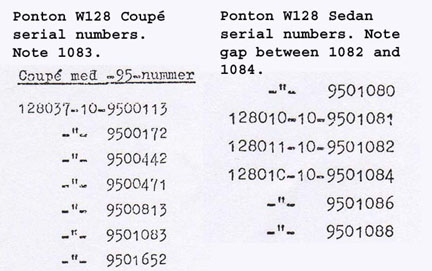 |
Table 3. Type W128 Serial Numbers
As such, there should never be a 220SE Ponton with a serial number higher than the total number of individual W128 body styles produced. That would be 1,974 sedans, 830 coupés, and 1,112 cabriolets or a total of 3,916 W128 series cars. In other words, no W128 serial number will be higher than 3916.
[10] Courtesy: Hartwig Mueller / January 17, 2008
[11] 127.980 (engine M127.I) up to chassis 002429. Data from Spare Parts List, Edition B, Printed in March 1960. Courtesy: Thomas Winberg / February 8, 2009
Table 4. Spare Parts List, Edition B (showing 220SE engine numbers)
[12] The 127.983 prefix is not used for cars earlier than VIN number 002430. i.e. 127.983 (engine M127.IV) was used from chassis 002430. The 127.983 engine has the same cold start solenoids as the Mercedes-Benz Fintail series. Data from Spare Parts List, Edition B, Printed in March 1960. Courtesy: Thomas Winberg / February 8, 2009
[13] Mercedes-Benz Personenwagen 1886-1986 / Werner Oswald / ISBN-13: 9783613011335 / ISBN-10: 3613011336
[14] Type 220S/SE coupé/cabriolet survivor survey data courtesy: Detlef Gonzalez / May 7, 2015 / updated: January 3, 2017. Link to the survey updated September 15, 2020.
Acknowledgements / References (II)
- Mercedes-Benz the First Hundred Years / © 1986 Richard Langworth / ISBN: 0-517-38199-0
- Mercedes Veterans website / Alex Gabard (Switzerland)
- The Mercedes-Benz Story / © 1979 Louis William Steinwedel / Library of Congress Catalog Card Number 79-83727
- Daimler-Benz in the Third Reich / © 1998 Neil Gregor / ISBN: 0-300-07243-0
- Das Werk Sindelfingen / © 1990 DBAG / Photo of Type 180 sedan at diagnostic station and some post-War Sindelfingen photos courtesy: Klaus Doehring (Germany)
- Mercedes-Benz Illustrierte magazine / Aerial photo of the Sindelfingen Works circa 1955 / Courtesy: Clifford J. "Jay" Lockrow Jr. / Hamburg, New York. This factory-authorized publication Mercedes-Benz "Pictorial" appears to be written for the British customers (refers to trucks as "lorries"). Mr. Lockrow's father (Clifford J. Lockrow of Orchard Park, New York) had numerous pieces of literature from the Mercedes-Benz Club of Great Britain in his collection / January 2005
- 1939 aerial photo of the Sindelfingen Works courtesy: Hartwig Mueller / Dortmund, Germany / February 3, 2005
- Photocopy of the W128 coupé and sedan serial numbers courtesy: Thomas Winberg of Halmstad, Sweden. December 2, 2007. The data originated with a Mercedes-Benz agent in Sweden and was passed down through several 220SE owners.
- Photo of Sindelfingen parking lot courtesy Matias Bombal / September 24, 2013
- Annual production data table from Mercedes-Benz Personenwagen 1886-1986 / © 1986 Werner Oswald / print courtesy: Bob Gunthorp / July 18, 2014
- Photo of Mercedes-Benz factory showroom with 190SL and two sedans courtesy Matias Bombal / May 13, 2017
Created: January 5, 2002 / Jeff Miller
Revision 38 / August 1, 2022
© www.mbzponton.org
Return to the Ponton Workshop page
Return to the Mercedes Ponton page
